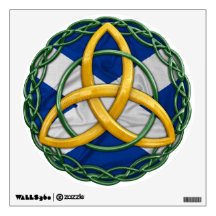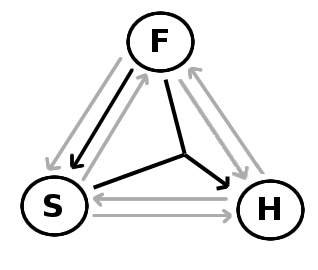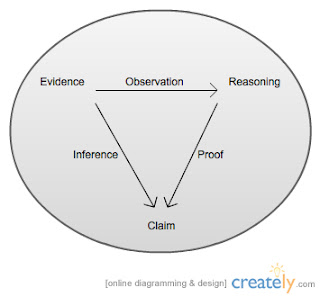By GJ Gillespie
We see in my other essay that the Toulmin Model of Inductive Arguments might be compared to the Christian trinity in that Reasoning is like the Son, Evidence is like the Father and the Claim is like the Holy Spirit.
Here I speculate that three basic types of arguments may also be analogous to the trinity.
First consider the three types of arguments: Arguments by rational analysis, arguments by credible authority and arguments by emotional narrative.
 Incorporating all three elements of the triad is necessary to form the strongest possible argument case. Yet at the same time, each element possesses unique persuasive force that stands alone. There is unity in diversity in pure eloquence. When we look closely at the nature of each facet we find a correspondence with the three persons of the Christian trinity, shedding new light on the nature of effective rhetoric.
Incorporating all three elements of the triad is necessary to form the strongest possible argument case. Yet at the same time, each element possesses unique persuasive force that stands alone. There is unity in diversity in pure eloquence. When we look closely at the nature of each facet we find a correspondence with the three persons of the Christian trinity, shedding new light on the nature of effective rhetoric. 1. Arguments by analysis or sequential thinking may be associated with the divine Logos, the Word of God or the Son of God.
Analytical arguments require information processing on the left side of the brain.
There are two kinds of analytical arguments. The first are arguments by definition or genus (based on reasoning from generalization).
"All arguments made through genus are arguments based on the nature of the thing which is said to constitute the genus," according to rhetorician Richard Weaver who placed this form at the top of his hierarchy for ethical debate. (Weaver, Richard, The Ethics of Rhetoric. Chicago: Henry Regnery Company, 1953. 56).
Here the speaker appeals to rational principles or values which if accepted lead to conclusions.
"All men are created equal," or "Democratic forms of government are best". We know that slavery is wrong because all men are created equal. We oppose dictatorships because democratic systems are ideal.
Appealing to powerful principles in proving a point is known as deductive reasoning. The debaters draws conclusions based on larger premises already accepted by the audience. Utilizing deductive reasoning is like a ship captain looking to the North Star to guide a sea voyage.
A debater also uses left-brain thinking in making a second form of argument based on seeing cause-effect relationships.
"Since oil fracking pollutes ground water it should be banned." "We should reduce the size of government since lower taxes and fewer regulation spurs economic growth."
When an effect is attributed to a cause the mind begins with particular information that lead to a conclusion sequentially.
Argument from cause flows like an electrical current in an electronic device. Like cause-effect reasoning the persuasive power flows from a generating source to a destination which illuminates the light bulb.
Cause effect arguments are based on inductive reasoning -- when a speaker begins with diverse data or evidences which taken together make sense in the conclusion. The components of these arguments are particle-like -- the bits are fit together to form a coherent whole.
2. Argument by Authority may be associated with God the Father.
These are arguments which rely on the strength of a trusted external source. Weaver offered the maxim "an argument based on authority is as good as the authority."(Johannesen, Richard L., Rennard Strickland, & Ralph T. Eubanks, Eds. Language Is Sermonic: Richard M. Weaver on the Nature of Rhetoric. Baton Rouge: Louisiana State UP, 1970. 216.)
 |
| And I Think to Myself by GJ Gillespie. |
We do not accept the proof because we "think it through" ourselves. Rather we are persuaded by a conclusions of a credible outside source who we trust.
Ethos or ethical appeal--as defined by Aristotle --is probably the most powerful form of persuasion. When an audience respects the source of the information the conclusion advanced is usually accepted. We will be move moved to accept the position of an expert in a field with advanced degrees more readily than the opinions of a child or criminal.
Expertise is a test of evidence. We ask, does the source have the qualification to make this claim? Can we trust this source? Highly credible authorities are difficult to dismiss since we are drawn by the persuasive force of their reputation and experience. Like smaller celestial objects attracted to the gravitational pull of a more massive object such as a planet, star or black hole, we are pulled in by the gravity of a expert's views.
When we take the whole universe into account, we see that only some objects possess a gravitational field. Most objects, such as a small asteroid or a single person, have a very weak gravitational attraction. In the same way, in the universe of a controversy only some sources have strong attraction. A speaker or writer will seek to discover which sources out of thousands have the rhetorical mass necessary to pull listeners into persuasive orbit.
In this way, referring to authority is as natural as gravity. It keeps our feet on the ground. By taking on the mind set of an authority the tentative thinking of listeners is brought into focus. Learning from authorities is essential for human interaction. Children learn from parents, students from teachers, novices from mentors and we all are influenced by opinion leaders in our social sphere. Humans are necessarily social creatures who, like our ancestors ten thousand years ago, look to tribal leaders for guidance.
The wholly other God the Father is the most powerful authority imaginable. In the old testament we see that God issues the ten commandments to Moses. The ancient Hebrew community accepted the commandments because of the authority that issued them. Sacred scriptures of various religions -- as well as founding legal documents of a nation such as the Declaration of Independence or the US Constitution -- are accepted on the basis of authority.
3. Arguments by Narrative may be associated with the Holy Spirit.
Telling a story which encapsulates your argument is persuasive since it appeals to emotional meaning that is processed on the right side of the brain. We are captivated by vivid stories or analogies that clarify an abstraction in our mind. Here the speaker appeals to the intuition or "heart knowledge" of the audience. It is the Pathos of Aristotle's classical proof.
Rather than sequential, bit by bit reasoning of cognitive analysis, intuitive thinking is "all at once" insight that comes from deep places of human unconsciousness.
Blooms cognitive domain is well known. But, he also referred to the affective domain of emotional meaning. Some people have high IQs, or intelligence, others have high EQs, or what is called emotional intelligence.
Weaver categorizes emotional arguments as those that appeal to similitude, analogy or metaphor. Poetic forms of expression often can say more than the propositions of rational thought since right brain holistic information processing permits "pattern recognition". This is the creative side of human consciousness.
It is said that all language is metaphorical. New words are generated on the right, emotional side of the brain where similarities between diverse objects and experiences are perceived.
"My love is a red, red rose" is a metaphor that compares a plant to a person. Rationally such a comparison may be groundless, but emotionally the poetic image is appealing.
While rational proof and the proclamations of authority is "particle-like" when bits of data are added up to form a whole, narrative arguments are "wave-like" or "fuzzy". Waves of emotion carry the listener to the conclusion. We believe because of the gut level, all at once pattern recognition of emotional intuition.
Story telling is the most effective way to stir emotional in an audience. An inspiring narrative may make the point better than any argument from reasoning or authority alone.
 After
hearing a vivid, emotional story our consciousness is transformed on a
deep level. Like the revelation of the Holy Spirit, intuitive arguments
provide insight that we know is true. We are convicted or enlightened.
After
hearing a vivid, emotional story our consciousness is transformed on a
deep level. Like the revelation of the Holy Spirit, intuitive arguments
provide insight that we know is true. We are convicted or enlightened.The intuitive, emotional pathway to knowing leads us to valid conclusions unattainable by the digital, left sided thinking of reasoning.
Electric pianos have two master keys. One switch is labeled digital and the other analogical. When the digital mode is on, the piano sounds like a traditional piano. When the analogical switch is on, the music may sound like a drum, guitar or violin.
The difference between digital and analogical information is like the difference between music played on a CD and a vinal record. Some music lovers prefer vinal records because the life-like imperfections remind them of a live performance. The perfectly clear CD technology eliminates the random imperfections of authentic human experience.
In the same way, arguments by narrative express analogical meaning that permits a speaker to slip past the rational defenses of the audience and get to the heart of an issue.
Traditional formulations of the trinity assert that the Spirit proceeds from the Father and from the Son. Applied to our model this could be taken to mean that effective emotional arguments must follow careful reasoning that is also consistent with trustworthy authority. In this way, creative thinking expressed as narratives, metaphor or analogies must proceed from established reasoning and authority.

Overall, all three types of interconnected arguments will be present in the most persuasive cases. For example, the persuader will present some rational arguments, perhaps citing statistics, or show that advantages of a proposal outweigh the disadvantages. The speaker will refer to the positions of authorities respected by the audience. Finally he or she will tell stories, provide analogies or make creative metaphors or employ poetic figures of speech. Taken together this triad of proof make up the essence of eloquence.
GJ Gillespie


